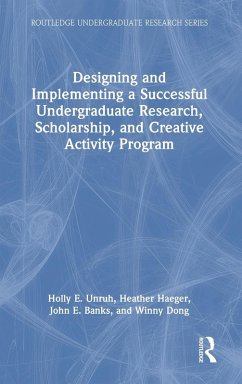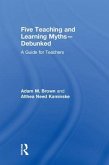Holly Unruh, Heather Haeger, John Banks
Designing and Implementing a Successful Undergraduate Research, Scholarship and Creative Activity Program
Holly Unruh, Heather Haeger, John Banks
Designing and Implementing a Successful Undergraduate Research, Scholarship and Creative Activity Program
- Gebundenes Buch
- Merkliste
- Auf die Merkliste
- Bewerten Bewerten
- Teilen
- Produkt teilen
- Produkterinnerung
- Produkterinnerung
Designing and Implementing a Successful Undergraduate Research, Scholarship, and Creative Activity Program is designed as a resource for faculty, administrators and university leaders interested in developing new, or expanding existing, undergraduate research programs.
Andere Kunden interessierten sich auch für
![Designing and Implementing Interdisciplinary Education Designing and Implementing Interdisciplinary Education]() Zehui ZhanDesigning and Implementing Interdisciplinary Education179,99 €
Zehui ZhanDesigning and Implementing Interdisciplinary Education179,99 €![Research, Writing, and Creative Process in Open and Distance Education Research, Writing, and Creative Process in Open and Distance Education]() Research, Writing, and Creative Process in Open and Distance Education55,99 €
Research, Writing, and Creative Process in Open and Distance Education55,99 €![Research, Writing, and Creative Process in Open and Distance Education Research, Writing, and Creative Process in Open and Distance Education]() Research, Writing, and Creative Process in Open and Distance Education66,99 €
Research, Writing, and Creative Process in Open and Distance Education66,99 €![Creative and Inclusive Research Methods in Sport, Physical Activity and Health Creative and Inclusive Research Methods in Sport, Physical Activity and Health]() Bonnie PangCreative and Inclusive Research Methods in Sport, Physical Activity and Health165,99 €
Bonnie PangCreative and Inclusive Research Methods in Sport, Physical Activity and Health165,99 €![Five Teaching and Learning Myths-Debunked Five Teaching and Learning Myths-Debunked]() Adam M. BrownFive Teaching and Learning Myths-Debunked130,99 €
Adam M. BrownFive Teaching and Learning Myths-Debunked130,99 €![Advancing Student Employability Through Higher Education Advancing Student Employability Through Higher Education]() Advancing Student Employability Through Higher Education149,99 €
Advancing Student Employability Through Higher Education149,99 €![Designing and Implementing Effective Professional Learning Designing and Implementing Effective Professional Learning]() John MurrayDesigning and Implementing Effective Professional Learning35,99 €
John MurrayDesigning and Implementing Effective Professional Learning35,99 €-
-
-
Designing and Implementing a Successful Undergraduate Research, Scholarship, and Creative Activity Program is designed as a resource for faculty, administrators and university leaders interested in developing new, or expanding existing, undergraduate research programs.
Produktdetails
- Produktdetails
- Verlag: Routledge
- Seitenzahl: 190
- Erscheinungstermin: 6. September 2024
- Englisch
- Abmessung: 235mm x 157mm x 15mm
- Gewicht: 434g
- ISBN-13: 9780367724825
- ISBN-10: 0367724820
- Artikelnr.: 70358756
- Herstellerkennzeichnung
- Libri GmbH
- Europaallee 1
- 36244 Bad Hersfeld
- gpsr@libri.de
- Verlag: Routledge
- Seitenzahl: 190
- Erscheinungstermin: 6. September 2024
- Englisch
- Abmessung: 235mm x 157mm x 15mm
- Gewicht: 434g
- ISBN-13: 9780367724825
- ISBN-10: 0367724820
- Artikelnr.: 70358756
- Herstellerkennzeichnung
- Libri GmbH
- Europaallee 1
- 36244 Bad Hersfeld
- gpsr@libri.de
Dr. Holly E. Unruh is Executive Director of the Arts Research Institute at the University of California, Santa Cruz. She previously served as Associate Director of the Undergraduate Research Opportunities Center at California State University, Monterey Bay. Dr. Heather Haeger is Research Director of the STEM Learning Center at the University of Arizona, and Assistant Professor of Educational Policy Studies and Practice. She served as the inaugural Assessment and Research Coordinator for the Council on Undergraduate Research from 2016 to 2020. Dr. John E. Banks is Director of the Undergraduate Research Opportunities Center at California State University, Monterey Bay. Dr. Winny Dong is Faculty Director of the Office of Undergraduate Research at Cal Poly Pomona and Professor of Chemical and Materials Engineering.
Acknowledgements
Notes on Contributors
Series Foreword
Jenny Olin Shanahan, Bridgewater State University
Gregory Young, Montana State University
Foreword to the volume
Ken O'Donnell, Vice Provost, California State University Dominguez Hills
Editor-in-Chief, Experiential Learning and Teaching in Higher Education
Chapter 1: The importance of undergraduate research, scholarship and
creative activity
Chapter 2: So you want to start an undergraduate research office?
Chapter 3: Staffing and office structure
Chapter 4: Ready, set, go! Goals for the first year
Chapter 5: Finding funding to support students, mentors and your
programmatic needs
Chapter 6: Beyond the lab/studio/archive: professional development support
for student researchers from across the disciplines
Chapter 7: Facilitating the mentor/mentee relationship
Chapter 8: Top down, bottom up: Tenure, promotion, and other faculty and
mentor support strategies
Chapter 9: Navigating institutional bureaucracy: risk management, research
supplies, travel, and other administrative concerns
Chapter 10: Getting the word out to students
Chapter 11: Assessment and educational research
Chapter 12: Scaling up access and reducing barriers to undergraduate
research: course-based undergraduate research experiences and faculty
mentor development
Chapter 13: Intersecting impact: aligning meaning-making for undergraduate
researchers
Chapter 14: Resources to Engage in the Community of URSCA Scholars and
Practitioners
Bibliography and Additional Readings
Index
Notes on Contributors
Series Foreword
Jenny Olin Shanahan, Bridgewater State University
Gregory Young, Montana State University
Foreword to the volume
Ken O'Donnell, Vice Provost, California State University Dominguez Hills
Editor-in-Chief, Experiential Learning and Teaching in Higher Education
Chapter 1: The importance of undergraduate research, scholarship and
creative activity
Chapter 2: So you want to start an undergraduate research office?
Chapter 3: Staffing and office structure
Chapter 4: Ready, set, go! Goals for the first year
Chapter 5: Finding funding to support students, mentors and your
programmatic needs
Chapter 6: Beyond the lab/studio/archive: professional development support
for student researchers from across the disciplines
Chapter 7: Facilitating the mentor/mentee relationship
Chapter 8: Top down, bottom up: Tenure, promotion, and other faculty and
mentor support strategies
Chapter 9: Navigating institutional bureaucracy: risk management, research
supplies, travel, and other administrative concerns
Chapter 10: Getting the word out to students
Chapter 11: Assessment and educational research
Chapter 12: Scaling up access and reducing barriers to undergraduate
research: course-based undergraduate research experiences and faculty
mentor development
Chapter 13: Intersecting impact: aligning meaning-making for undergraduate
researchers
Chapter 14: Resources to Engage in the Community of URSCA Scholars and
Practitioners
Bibliography and Additional Readings
Index
Acknowledgements
Notes on Contributors
Series Foreword
Jenny Olin Shanahan, Bridgewater State University
Gregory Young, Montana State University
Foreword to the volume
Ken O'Donnell, Vice Provost, California State University Dominguez Hills
Editor-in-Chief, Experiential Learning and Teaching in Higher Education
Chapter 1: The importance of undergraduate research, scholarship and
creative activity
Chapter 2: So you want to start an undergraduate research office?
Chapter 3: Staffing and office structure
Chapter 4: Ready, set, go! Goals for the first year
Chapter 5: Finding funding to support students, mentors and your
programmatic needs
Chapter 6: Beyond the lab/studio/archive: professional development support
for student researchers from across the disciplines
Chapter 7: Facilitating the mentor/mentee relationship
Chapter 8: Top down, bottom up: Tenure, promotion, and other faculty and
mentor support strategies
Chapter 9: Navigating institutional bureaucracy: risk management, research
supplies, travel, and other administrative concerns
Chapter 10: Getting the word out to students
Chapter 11: Assessment and educational research
Chapter 12: Scaling up access and reducing barriers to undergraduate
research: course-based undergraduate research experiences and faculty
mentor development
Chapter 13: Intersecting impact: aligning meaning-making for undergraduate
researchers
Chapter 14: Resources to Engage in the Community of URSCA Scholars and
Practitioners
Bibliography and Additional Readings
Index
Notes on Contributors
Series Foreword
Jenny Olin Shanahan, Bridgewater State University
Gregory Young, Montana State University
Foreword to the volume
Ken O'Donnell, Vice Provost, California State University Dominguez Hills
Editor-in-Chief, Experiential Learning and Teaching in Higher Education
Chapter 1: The importance of undergraduate research, scholarship and
creative activity
Chapter 2: So you want to start an undergraduate research office?
Chapter 3: Staffing and office structure
Chapter 4: Ready, set, go! Goals for the first year
Chapter 5: Finding funding to support students, mentors and your
programmatic needs
Chapter 6: Beyond the lab/studio/archive: professional development support
for student researchers from across the disciplines
Chapter 7: Facilitating the mentor/mentee relationship
Chapter 8: Top down, bottom up: Tenure, promotion, and other faculty and
mentor support strategies
Chapter 9: Navigating institutional bureaucracy: risk management, research
supplies, travel, and other administrative concerns
Chapter 10: Getting the word out to students
Chapter 11: Assessment and educational research
Chapter 12: Scaling up access and reducing barriers to undergraduate
research: course-based undergraduate research experiences and faculty
mentor development
Chapter 13: Intersecting impact: aligning meaning-making for undergraduate
researchers
Chapter 14: Resources to Engage in the Community of URSCA Scholars and
Practitioners
Bibliography and Additional Readings
Index









